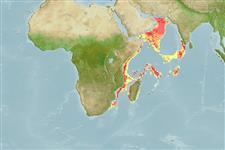Elasmobranchii (tubarões e raias) (sharks and rays) >
Carcharhiniformes (Ground sharks) >
Pentanchidae (Deepwater catsharks)
Etymology: Bythaelurus: bythos (Gr.), depths of the sea, referring to its deepwater habitat; ailouros (Gr.), cat, probably an allusion to the vernacular “catshark,” so named for its cat-like eyes. (See ETYFish); tenuicephalus: tenuis (L.), slender; cephalus, from kephale (Gr.), head, referring to its “remarkably” narrow head and snout. (See ETYFish).
Environment: milieu / climate zone / depth range / distribution range
Ecologia
marinhas; intervalo de profundidade 463 - 550 m (Ref. 106604). Tropical
Distribuição
Países | Áreas FAO | Ecossistemas | Ocorrências | Point map | Introduções | Faunafri
Western Indian Ocean: off Tanzania and Mozambique.
Tamanho / Peso / Idade
Maturity: Lm ? range ? - ? cm
Max length : 300 cm TL macho/indeterminado; (Ref. 106604)
Descrição breve
Morfologia | Morfometria
This species is distinguished from its congeners by the following characters: slender head and snout, only slightly bell-shaped in dorsoventral view without distinct lateral indention (vs. distinctly bell-shaped snouts with a strong lateral indention anterior to outer nostrils); has broader claspers in adult males, the base width 2.1% TL (vs. 1.51.8% TL of congeners in the western Indian Ocean); further differs from B. clevai by having a smaller maximum size and a color pattern of fewer and smaller blotches, larger oral papillae, a shorter snout, and broader claspers without knob-like apex and with a smaller envelope and a subtriangular (vs. subrectangular) exorhipidion; differs from B. hispidus by having a longer snout, a longer dorsal-caudal space, broader clasper without knob-like apex, and fewer vertebral centra; differs from B. lutarius by having a smaller maximum size and has a blotched (vs. largely plain) coloration, numerous (vs. lacking) oral papillae, shorter anterior nasal flaps, a longer caudal fin, a shorter pelvic anal space, and shorter and broader claspers (Ref. 104913).
Life cycle and mating behavior
Maturidade | Reprodução | Desova | Ovos | Fecundidade | Larvas
Kaschner, C.J., S. Weigmann and R. Thiel, 2015. Bythaelurus tenuicephalus n. sp., a new deep-water catshark (Carcharhiniformes, Scyliorhinidae) from the western Indian Ocean. Zootaxa 4013(1):120-138. (Ref. 104913)
Categoria na Lista Vermelha da IUCN (Ref. 130435)
Ameaça para o homem
Harmless
Utilização humana
Mais informação
PaísesÁreas FAOEcossistemasOcorrênciasIntroduçõesStocksEcologiaDietaItens alimentaresConsumo alimentarRação
Nomes comunsSinónimosMetabolismoPredadoresEcotoxicologiaReproduçãoMaturidadeDesovaAgregação para desovaFecundidadeOvosDesenvolvimento dos ovos
Idade/TamanhoCrescimentoComprimento-pesoComprimento-comprimentoFrequência de comprimentoMorfometriaMorfologiaLarvasDinâmica larvarRecrutamentoAbundânciaBRUVS
ReferênciasAquaculturaPerfil para aquaculturaEstirpesGenéticaElectrophoresesHereditariedadeDoençasProcessamentoNutrientsMass conversion
ColaboradoresFotografiasStamps, Coins Misc.SonsCiguateraVelocidadeTipo de nataçãoÁrea branquialOutras referênciasCérebrosVisão
Ferramentas
Relatórios especiais
Descarregue XML
Fontes da internet
Estimates based on models
Phylogenetic diversity index (Ref.
82804): PD
50 = 0.5001 [Uniqueness, from 0.5 = low to 2.0 = high].
Bayesian length-weight: a=0.01000 (0.00244 - 0.04107), b=3.04 (2.81 - 3.27), in cm total length, based on all LWR estimates for this body shape (Ref.
93245).
Nível Trófico (Ref.
69278): 5.0 ±0.5 se; based on size and trophs of closest relatives
Resiliência (Ref.
120179): Muito baixo, tempo mínimo de duplicação da população maior que 14 anos (Preliminary K or Fecundity.).
Fishing Vulnerability (Ref.
59153): Very high vulnerability (90 of 100).
